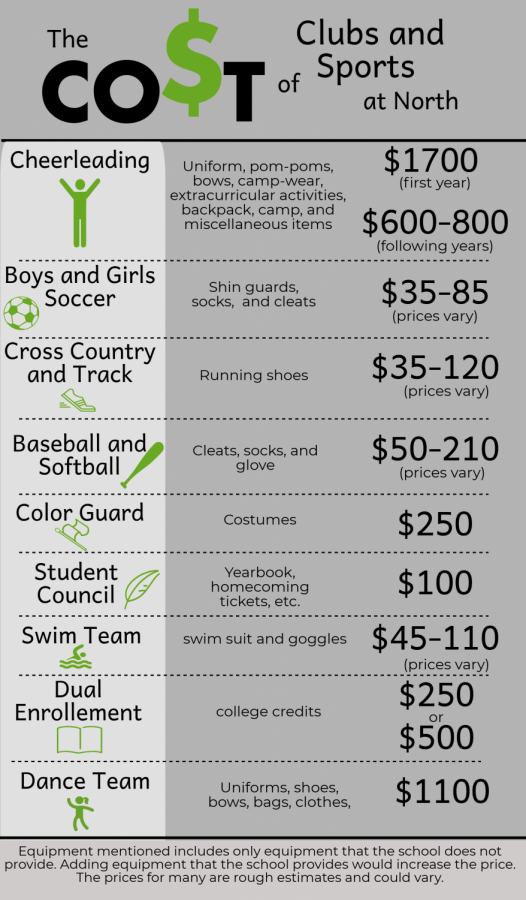The cost of belonging
October 26, 2018
The football team scores a touchdown. The Omaha North Vikings now have a 7-point lead. The crowd is full of students on their feet. The field is full of football players highfiving after the small achievement, with the energy in the stadium is at a high. To keep the energy going, the cheer team makes their way to the field.
The cheer team takes formation, ready to begin their routine. The cheerleaders stand in a line, wearing their blue skirts with white trim and blue shirts with the word Viking spread across the chest. Their golden pom-poms gleam in the light and their hair is tied back with North Cheer team bows.
After a successful game and long night of keeping the crowd excited and rooting for the football team, the cheerleaders slide into their North blue sweatpants and matching jacket with North Cheer embroidered into it. They throw their cheer team backpacks with their names embroidered in them, over their shoulders and exit the stadium.
What students may not realize when watching the cheerleaders cheer on the football team is the underlying expenses that go into being a part of this team.
Every year, clubs and activities at North have to pay for special equipment or events involved with that club or sport.
According to team coach, Jamie Brown, as a freshman joining the cheer team this previous year, the price to join was around $1700. This payment includes their uniform, pom-poms, bows, camp wear, extracurricular activities, camp, backpacks, and other miscellaneous items.
Over the next three or less years, the price to participate goes down to around $600 to $800, as the uniform has already been paid for.
Freshman at North, Jessica Wynne, decided to join cheer team this year because she had always been a part of individual sports such as track. She “wanted to be part of a team,” completely unaware of the price that it costs to be part of a team.
“Personally, I felt scared about [the cost]. How would we pay it?” Wynne said.
Brown said she tries hard to, “work with the girls” in regard to the money.
“All of the money is out of pocket. There is no funding from the school,” Brown said.
To help make this amount of money slightly easier to swallow, Brown develops a four-month payment plan where the cheerleaders only pay once a month. This way families of the cheerleaders don’t have to pay the money all at once.
Along with the payment plan, there are also fundraising activities that the girls can participate in.
For example, most years the team sells frozen food. Brown said that it depends on the individual girl; they can gain up to $500 but most commonly get anywhere from $150 to $250.
Wynne went door to door with her frozen food catalogue selling food to neighbors, friends, and family members. Along with the money she gained from fundraising, Wynne had to pay $150 of it while her mom paid for the rest.
“At first [my mom] was frustrated about how expensive it was, but once we paid it off, it wasn’t too bad,” Wynne said. “She loves that I do cheer because it’s something I’m pretty decent at and I enjoy.”
Cheer averages out to be the most expensive activity that North offers with no financial aid.
For example, Student Council members pay $100 to join or that the soccer team must provide their own shin guards, cleats, and socks.
Along with the price of being involved with certain clubs and sports, some classes at North cost students money as well.
For example, some AP classes offer dual enrollment. This is when a student pays a certain amount of money to have their high school credit of that class transfer to college credits. Depending on the class, it costs either $250 or $500 depending on the number of semesters signed up for and the college credits that it gives.
While this is significantly cheaper than the cost of that class in college, not all students are accustomed to paying these large sums of money, especially if they plan on dual enrolling in several classes.
Since not everyone can afford to pay for opportunities and activities such as dual enrollment, there are various financial aid options around school.
For dual enrollment, there is the ACE scholarship which allows many students who are free and reduced lunch to have some of their dual enrollment classes covered.
To some students and their families, the amount of money that students pay for with their clubs, sports, activities, dual enrollment, class trips, etc. is not worth it. However, to others, it could be considered money well spent.
“[The amount of money] is worth it. Especially when you think about the bonds that you make with the girls,” Brown said.



